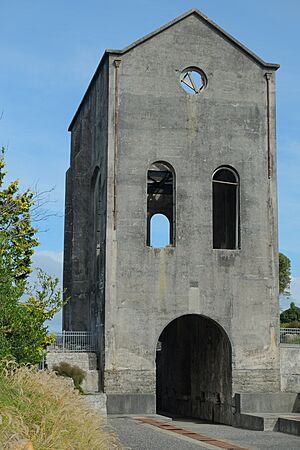Martha Mine facts for kids
The Martha Mine is a famous gold mine located in the town of Waihi, New Zealand. Since July 2015, it has been owned by a company called OceanaGold. This mine has a long history and has produced a lot of gold and silver over the years.
Contents
The Story of Martha Mine
The Martha Mine began when a man named William Nicholl claimed a piece of land. He named it "Martha" after someone in his family. Soon, several smaller land claims joined together to form the Martha Company. By 1882, the first machine to crush gold-bearing rocks was working.
The Martha Mine grew into one of the most important gold and silver mines in the world. This happened because new methods, like using cyanide, made it easier to get gold from rocks that didn't have much gold in them. Because of the mine, Waihi became a very busy town. By 1908, it was the fastest-growing town in the Auckland Province.
In 1935, during a tough economic time called the Depression, New Zealand produced a lot of gold. The Waihi Company, which owned the Martha Mine, produced two-thirds of it! For tax reasons, the Waihi Company was split into three parts that year. One of these was the Martha Company, which then controlled the Martha Mine.
By the 1950s, the mine faced many challenges. The main problem was the international price of gold, which was fixed at $US35 an ounce. This limited how much money the mine could make. Also, the mine needed a lot of money to buy new machines, but they didn't have it. There were also not enough workers because of two World Wars and the Depression. These problems led to the underground mine closing in 1952.
The Open-Cast Mine Begins
In the 1970s and early 1980s, the price of gold went up. Mining experts found more gold that could be dug up using a cheaper method called "open pit" or open-cast mining. This means digging a large hole from the surface instead of tunnels underground. The mine was reopened as an open pit in 1988.
In April 2015 and April 2016, big landslides happened at the mine. These landslides stopped the mining work. In March 2018, OceanaGold announced "Project Martha." Part of this project was to fix the road used by trucks in the pit so that mining could start again.
The Cornish Pumphouse
The "Cornish Pumphouse" is a special building. It was first built in 1904 near the Martha Mine. Its job was to hold a huge steam engine that pumped water out of the mine. The building's design came from tin mines in Cornwall, England.
This large pump worked until 1913. It could lift water from about 400 meters (1,300 feet) deep! It pumped over 400,000 liters (105,000 gallons) of water every hour. After 1913, electric pumps were used to remove water from the mine. But the pumphouse was kept ready as a backup until 1929.
From the 1930s, all the machinery was removed from the building. It slowly became old and broken. In 1983, the building was listed as a Historic Place. This was because it is a very important industrial building in New Zealand's history.
In 2001, the area around the pumphouse was fenced off because the ground nearby started to sink. Experts decided the only way to save the building was to move it to a safer place. The plan to move the Cornish Pumphouse started in 2006. The building, which weighed 1,840 tonnes (over 4 million pounds), was moved 300 meters (980 feet) over three months. It slid along special concrete beams. Now, it is in a new spot that is easy to visit by walking from Seddon Street.
Some of the steel supports used for the move are still inside the building. People can visit and see the pumphouse during the day.
Other Underground Mining Today
Since 2004, new underground mines have been opened. They are all reached through one entrance called the Favona portal. These mines, named Favona, Trio, and Correnso, run beneath much of the town of Waihi. They produce about 100,000 ounces of gold each year.
How Much Gold and Silver Has Been Produced?
From the 1880s to 1952, the Martha Mine was an underground mine. It became one of the most important gold and silver mines in the world. By 1952, when this part of the mine closed, about 5.6 million ounces (174,160 kg) of gold and 38.4 million ounces (1,193,180 kg) of silver had been dug up. This came from 11,932,000 tonnes of rock.
The modern Martha Mine has been an open pit mine since 1987. Since 1988, it has produced around 100,000 ounces of gold and 700,000 ounces of silver every year.
Mine Challenges and Community Impact
When the mine wanted to expand in 1987, some people protested about environmental concerns. In 2001, the ground in the area sank, causing a house to collapse. The company that runs the mine has agreed to pay money to about 130 homes. This is to help with problems like noise, shaking from blasts, and dust from the mine.



